Clivia in California
Clivia in California
Michael Barrett
The topic for the April meeting was inspired by thought of our Northern hemisphere friends and fellow Clivia enthusiasts and the main C. miniata flowering season they enjoy in March and April. Whist there was a marvelous tour of China and Japan, enjoyed by some members, I will have to make that trip another year. My thoughts turned to another centre of Clivia excellence, the USA, and in particular to California. I haven’t visited California and certainly no authority on this topic, but used a variety of print and electronic resources, conversations and emails exchanges to gain an understanding of the past and present activities of Clivia folk. Thus this virtual vacation of sorts was a brief overview or a snap shot, as it would be impossible to even just mention all the people involved at a variety of levels with Clivia in California. Some MCG members may personally know different personalities from California, via conferences, tours or more commonly online chat groups, and indeed may have offsets from imported named plants, or at least seedlings from named plant crosses in their collections. The committee agreed it would be of interest to a variety of members, especially newer members who may have heard of some breeder or named plants and wish to know more. The presentation took the form of a PowerPoint display, and was highly illustrated. This article is a write up of some of the points covered. In the course of researching for the presentation, a number of similarities between Clivia in California and Clivia in Australia came to mind. One of the most striking similarities is with members scattered over various locations, the tyranny of distance made attending meetings and shows a challenge. Another observation is that the beauty of Clivia has attracted nursey people and gardeners alike to hybridize and attempt to improve the genus long before the formation of clubs and associations dedicated to Clivia. However, it via organisations such as the North American Clivia Association, Clivia Society and similar clubs and groups in Australia that Clivia can be promoted in a particular way, with knowledge and plant material shared and enjoyed with interested members of the public.
California is located on the west coast of the United States with a coastline of some 1450 kilometers. Driving non-stop without traffic from north to south would take over 18 hours. The climate is principally described as Mediterranean, but of course holds a vast range of micro climates. The discovery of gold in 1848 significantly changed the future of California; its importance cannot be understated. Just like the state of Victoria, with its own gold rushes of the 1840’s to 1860’s, regional ‘boom town’ centres became famous for possible overnight wealth creation and activity, population dramatically changed and architecture of significance was built. California’s motto is ‘Eureka’, and for Australians, the Eureka Stockade, is one of the defining moments in our history. The Californian economy is the USA’s largest and if measured as a single economy would be the 8th largest in the world, with a trillion dollar gross state product. The major industries are agriculture, mining, electronics and technology, tourism and motion picture production. 1 in 8 US residents live in California, with a population of 39 million, and if considered as a nation would be the 35th most populous. The two biggest cities are Los Angeles and San Diego.
The first section of the presentation was based principally on Clivias, by Harold Koopowitz, with photography by James Comstock and a forward by Sir Peter Smithers. Clivias is a seminal monograph for most Clivia enthusiasts. It was published by Timber Press in 2002 and now out of print. Second hand copies are available via Amazon, and if possible purchase the hard copy for the photos are better in that format. Personally it had been the best source of information and inspiration, re-read and referred to often, and highly recommended for anyone new to Clivia.
Dr Harold Koopowitz is a well-respected botanist, Professor of Ecology and Evolutionary Biology at University of California and a well-known personality in orchid communities. He played a significant role in the International Bulb Society, and was awarded the Herbert Medal in 2003. He is concerned with research into loss of biodiversity and endangered plant communities. (http://www.faculty.uci.edu/profile.cfm?faculty_id=2583 )
James Comstock is a renowned photographer and garden designer living in California, who has been captivated by Clivia for the past thirty years. He is still a keen hybridizer, and has in the past commandeered friend’s backyard to accommodate his plants. His photography in Clivias provides a valuable source of information, as well as being beautiful images.
It is in Clivias that Koopowitz looks back to account for the early days of Clivia in California. He writes, “The horticultural history of any group of plants is really the story of a set of people who became interested in the plant and then proceeded to develop it” (p.169). A brief summary of breeders covered by Koopowitz follows with additional information.
Koopowitz writes that one person who had a large influence on Clivia in California was E.P. Zimmermann, who emigrated from Germany in 1907, and in 1927 at forty years of age settled in Carlsbad, southern California. Zimmermann claimed his family had been breeding Clivia for three generation or about 75 years. Zimmerman had originally wanted to grow Clivia for the cut flower trade, and had 5000 plants growing under “lath” (narrow strips of wood or lattice) presumably similar to a timber fernery. In 1943, his “strains” were described as being a “great improvement in size and shape and colour, ranging from creamy yellow to shades of orange to deep red”. Koopowitz, (quoting Drysdale) tells that 10 000 seeds were sent to Europe, and suggest this germ plasm may be of influence in today’s Clivia (p.178).
Koopowitz also details another two early breeders of Clivia. Horace Anderson had little interest in horticulture until his marriage, but went on to being called the ‘father of horticulture’ in California. He and wife Mary together ran La Costa Flower Shop and Nursery in Santa Monica in the early years of marriage. Horace and Mary’s interest grew in commercial plant production, particularly subtropical plants, including Philodendron. Horace’s grandson Eric, writing about his grandfather on the Anderson Seeds Company website (http://www.seedcoseeds.com/aboutus.htm), tells that Horace was intrigued as to why Philodendron were propagated by cuttings, instead of seed. Horace talked with Bill Evens, Head Landscaper at Disney and learned how to produce seed. Horace went on to hybridize a number of Philodendron plants and commercially developed and promoted Schefflera arboricola (from a cutting obtained from Huntington Gardens) as an indoor plant. Horace also discovered that Monstera seed was best obtained from the native habit, rather than trying to pollinate by hand. Anderson purchased 80 acres of land at Encinitas, near Carlsbad in 1954, and Koopowitz suggests Anderson would have dealt with Zimmerman. Anderson was also friends with Ed Hummel, a famous plant hybridizer of Euphorbia, Echeveria Hoya, Aloe and Clivia. Hummel gave Anderson a division of a yellow Clivia, but precisely when is not established. Seedlings from the yellow were backcrossed, and as Koopowitz points out, “repeating the paradigm used by Kew to improve its yellow plants” (p.179). After Horace’s death Mary was married to Ron Chamberlain another horticultural giant for over twenty years. Their beautiful landscaped gardens north of San Diego had a large Clivia collection (http://www.hortmag.com/gardens-and-gardeners/garden-visits/a_golden_climate). The Anderson commercial nursery is now run by Eric Anderson, and specializes in bulk seed sales. There is an American Anderson’s Peach, associated with Horace, totally unrelated and incompatible with the Toowoomba Anderson’s Peach. In Sydney, the Mouyat brothers have a number of plants known as Hummel hybrids.
At the time of publishing Clivias, Koopowitz was able to pay tribute to two giants of Clivia in California, Joe Solomone and Dave Conway. These two significant figures, now sadly passed on are honoured at NACS Californian shows with the best in category awards, for flower (Conway) and for foliage (Solomone). The two gentlemen had very different styles in the way they approach growing Clivia. A brief summary of Koopowitz, with additional information from other sources follows:
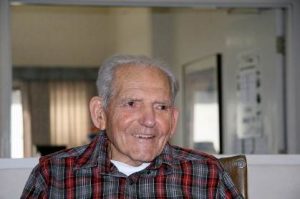
Photo Tom Wells
Koopowitz writes, “Joe Solomone is the king of Clivia of North America” (p.180). Back in the 1960’s Joe Solomone, a nurseryman from central California saw a pale yellow flower stuck down in the leaves of a particular Clivia amongst other Clivia for sale. Realizing its importance he purchased this plant and over the years began crossing and then backcrossing it to build stock of yellow Clivia. In the mid-nineties he started focusing more on breeding greater numbers of yellows, with an idea to export, but found local demand took his output. Joe was assisted for over twenty years by nurseyworker Maricela de la Toore. Maricela was responsible for pollination and selection of plants. The wholesale nursey called Plant Horizons is over three acres of covered growing houses, and the Clivia were mostly yellow and variegates. Joe son in law, Marcel Morales marketed the yellows as ‘Solomone Yellows’ and previously ran Monterey Bay Nursery. The variegated Clivia appeared spontaneously, but selected out and maintained. In fact very little material was bought in; the diversity came from growing in high numbers.
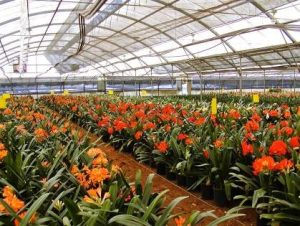
Photo Tom Wells
In 2005 a visit was made to Plant Horizons by an international party of Clivia folk. Amongst the visitors were Ken Smith, Alick Mcleman from New Zealand and Rudo Lötter as well as James and Connie Able from South Africa. Joe was presented with An Award of Merit from the Clivia Society in 2006. Joe was also awarded a Herbert Medal in 2008, the same year he passed away. Joe’s daughter Barbara and son in law Marcel now own Plant Horizons and are still assisted by Maricela.
David Jay Conway was a passionate man, about his family, trout fishing and Clivia. He was born in 1930 in Seattle, while his parent lived there for a short period, but moved back to California when he was six months old, making himself a seventh generation Californian, married his childhood sweetheart Nancy in 1952 (Bardossy, 2006). Interestingly Shields Gardens suggest both Dave and Nancy, who had an interest in genealogy, may be distant relations to Hugh Percy, 3rd Duke of Northumberland, and husband to Lady Clive, the Clivia genus’s namesake. Together

Photo Tom Wells
they made a large family, and moved about California. In 1970 the family moved to Santa Barbara, where they remained for the rest of their lives. Dave’s was Supervisor of Santa Barbara Parks and Recreation department. This position of authority would have given Dave the unique opportunity be able to select out and buy any plants that were out of the ordinary from nurseries. Dave is famous for one particular pollen experiment that created some of his named plants. In 1987 or 1988 he mixed pollen from his best plants into a container, and then crossed pollinated them all, harvested approximately 1000 seeds and these plants flowered in 1993. The wonderful photo named Conway’s Tea Party has long been admired for its beauty, and is an inspiration for many Clivia breeders. The photo was taken by James Comstock. Dave and Tom Wells worked together to identify and label the plants in another version.
This labelled photo shows that many of the plants were from a variety of sources, including Solomone, and not just entirely the results from the ‘pollen bomb’ bred by Dave. Interestingly, ‘Tessa’ and ‘Helen’ do not appear to be in the photo. Also of interest are two plants, ‘Particolor #6’ and ‘Free love’ both displaying particolour blushed flowers. ‘Cynthia Ann’ and ‘Margaret’ are named and are known particolours. Joe Solomone also had flowers that changed in colour over time; he referred to these as watercolours. In that Tea Party photo almost all plants have a name, naming plants was important to Dave. Originally Dave
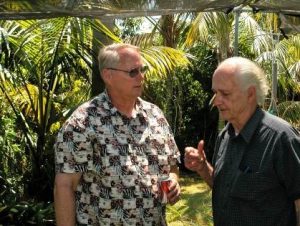
Photo supplied Tom Wells
named plants bred by himself after female members of his family, and gave different names to bought plants, however it is not clear if this was a strict rule. Dave gave plants names for his wife and daughters, and granddaughters, apart from one daughter who wanted a green flowered Clivia, something Dave didn’t manage to achieve. Tom Wells has an account of when Nancy came home Dave presented her with a plant named in her honour. She wasn’t overwhelmed by this particular Clivia, Dave was not going to unnamed the plant, so there is ‘Nancy’ but another plant was also named for her, ‘Nancy Marie’. Dave passed away in 2006 leaving a Clivia legacy still enjoyed today. Shields Gardens exported named offset around the world, his son Dave Jr maintained the collection for some time, and Craig Ruggles bought a significant number of plants. Huntington Gardens has almost all his named plants, and is trying to source missing plants to complete the collection.
The Conway legacy continues here in Australia as well. A number of named offsets have been
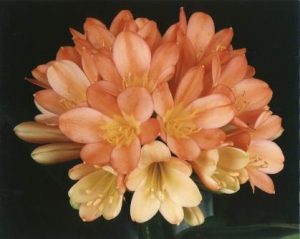
Photo James Comstock
imported by different individuals, including ‘Tessa’ and ‘Helen’. Another link is with the MCG and the Clivia Expo 2015. A number of years ago Hugh Bollinger in the USA made a cross between ‘Cynthia Ann’ and a pale Japanese yellow. Hugh sent some seeds to Harry Erasmus in Western Australia and John Craigie in Queensland. Harry named two of these seedlings ‘Out of the Blue’ and ‘The Artist’. Offsets of these plants were offered for auction at Clivia Expo last September.
To provide a contemporary element to the presentation Victor Murillo was contacted. In some ways, Victor has a blend of qualities from both of the previous Clivia giants. Victor Murillo has been patiently and methodically breeding Clivia for the past 18 years. Victor, his wife Danielle and two sons live in Fallbrook, San Diego County, not that far inland from Carlsbad. Fallbrook is also known as ‘Avocado capital of the world’. This title, can give us an idea of the micro climate, certainly different to our growing conditions in Melbourne, perhaps more like northern New
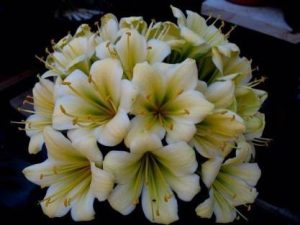
Photo Victor Murillo
South Wales or South Eastern Queensland. Victor works as an Inventory manager for a large commercial nursery with product line such as Cyclamen, Schlumbergera (zygo cacti) and ornamental peppers. This nursey had Clivia as a product line, but decided to not continue with them commercially. Victor was able to acquire the best of the plants for his personal breeding program. Amongst his original plants were two yellows from Vic Daniels, one clear yellow and the other with a green throat. From these plants he has bred his Green series, these group one yellows display an intense green. Victor has also developed his own Peach series, named Victorian peach. From these dark, mid and light peach he has selected out pinker flowers. He is also known for his interest in developing variegated and multi-petal plants. Victor received the Herbert Medal in 2012.
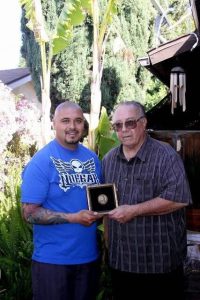
Photo Victor Murillo
Out of relative isolation from each other, various Clivia growers were beginning to hear about each other and build new networks. Randy Baldwin, from California has long been interested in Clivia and other drought tolerant plants. In 1981 he was employed as production manager for San Marco Growers, a very large commercial nursey. In 1990 he bought a share of the business and became general manager. This commercial nursey had networking association with a number of industry bodies. On the San Marco Growers’ website, https://www.smgrowers.com/search/basesearch.asp?strSearchText=clivia&x=0&y=0 Randy details two significant gatherings of Clivia enthusiasts. In 1996 an informal gathering of people came together at Huntington Gardens to share their passion for Clivia. Included were Randy, as well as James Comstock and Dave Conway. In March 2001, (during the C. miniata flowering season) a second Clivia symposium was held in the new botanical centre at the Huntington. This event was much more formal, and speakers included the director of the Huntington Gardens, Jim Folsom, as well as Harold Koopowitz and James Comstock with a draft of Clivias, Dave Conway, and international guest speakers Tino Ferao and Shigetaka Sasaki. James and Connie Able were in attendance signing up new members to the Clivia Society. Thus a strong link was made between the Huntington and Clivia promotion.
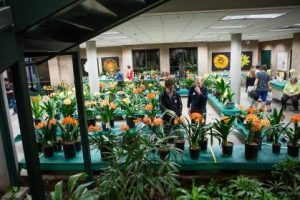
Photo Tom Wells
As noted by Koopowitz, electronic communications in part has increased interest in Clivia (p.19). These new communication platforms enabled people geographically distant from each other to come together to share knowledge and pictures of their plants. Marc Hamel provides an account of the birth of the North American Clivia Society.
“Starting I think in the spring of 2000 or 2001, there was a small group that used to meet every Sunday morning in an AOL chat room to talk about our favorite plant – the Clivia. The usual participants were Jim Shields, Tom Wells, Mike Morri, Pen Henry and myself. We often had others drop in from time to time but as the arteries in my brain continue to harden I have a tough time trying to remember them all. I know that Chris in Echuca was a frequent participant and Harry Erasmus would join from time to time and we learned a lot from him about his soil mix and feeding schedule. As time went on it became clear to us that the love of

Clivia was not limited to this small group and we were finding more and more people who shared our passion. I believe all of us were members of the Clivia Society in South Africa and as we learned more about their various regional clubs and shows, it dawned on us that there was no comparable society here in the US. We knew of so many other societies for flowers such as orchids, roses, chrysanthemums and daylilies just to name a few and decided that it was about time that there was a Clivia Society. After spending a good deal of time trying to come up with a suitable name and realizing that there were probably a good number of Clivia lovers in Canada as well as the US, we decided to call it the North American Clivia Society. And so in 2003 the first board was set up with Jim Shields as president, Tom Wells as vice president, Mike Morri as treasurer and myself as secretary. Mike got a bank account set up for us in Michigan and Jim set about working with a lawyer in Indiana to set us up as a non-profit organization. Jim knew that this fledgling organization would need more people to become involved and invited Kathy Andersen and Mike Riska to join. So now we had a core group dedicated to making Clivia more widely known and loved throughout North America and now 11 years later we have a large membership with some very talented and dedicated people moving us forward into our next decade.”
The Huntington Library, Art Collections and Botanical Gardens are located in San Marino, near Los Angeles. It is one of the United States largest and wealthiest private and not for profit institutions. It is a collection of specialist research and educational departments that were founded as a trust in 1919 by Henry E Huntington and his second wife Arabella. Both were passionate collectors, and had a love of gardens. They built the majority of the art collection in the years immediately after WW1 when 18th and 19th century masterpieces were being sold in great quantities. The art collection, housed in what was originally the Huntington family residence includes Sir Joshua Reynold’s ‘Blue Boy’, and Thomas Lawrence’s ‘Pinkie’ as well as significant American art from all periods. The Library has a significant collection of rare books amongst its 6 million or so items included one of only 11 known remaining Gutenberg Bible, the manuscript of Chaucer’s Canterbury Tales and significant collections of letters of American Presidents. The gardens are spread over 120 acres that were once part of a larger working ranch with orchards and livestock. There are a variety of sculptures from classical to modern spread over the grounds. The area is divided into themed garden areas, including by nationality or style Australian, Chinese, Japanese, ranch and Shakespearian, by climate zone; desert, and subtropical or by genus, camellia, palm, and rose gardens. The Huntington website is an informative and entertaining visit in itself, (http://www.huntington.org/).
The NACS has held its show at The Huntington’s Brody Botanical Centre for the last eight years. The plants are displayed on low platforms. It is a competitive show, with a variety of classes, including cut flowers, photographic and floral art categories. The quality of plants on display is as exceptional as one could hope to see anywhere, with some international named imports, yet overall with a strong Californian heritage. Entry to the Clivia show is part of the admission to the Huntington Gardens. The 2017 Huntington NASC show and sale will be held over the weekend of the 18/19th of March, one week later than the Longwood show.
I wish to thank Victor Murillo, Marilyn Paskert and Tom Wells for the tremendous generosity of time and knowledge in the course of preparing the presentation and this article. I hope one day I may thank you in person.

